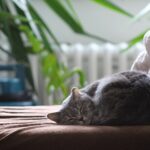Cats are enigmatic creatures, and their behavior can often leave pet owners puzzled. One common phenomenon that pet owners experience is their feline companions suddenly rejecting dry food. This behavior can be frustrating and concerning, leading to questions about their health, lifestyle, and dietary preferences. In this comprehensive article, we will delve into the reasons why your cat may suddenly turn its nose up at dry food, explore the potential health implications, and offer actionable solutions to ensure your beloved pet remains happy and healthy.
Table of Contents
- Understanding Cat Behavior
- Common Reasons for Rejecting Dry Food
- 2.1 Health Issues
- 2.2 Taste Preferences
- 2.3 Food Freshness
- 2.4 Dietary Changes
- 2.5 Environmental Factors
- Health Implications of a Sudden Food Rejection
- How to Encourage a Return to Dry Food
- Alternatives to Dry Food
- Conclusion
1. Understanding Cat Behavior
Cats are creatures of habit with distinct personalities. Their food preferences can be influenced by various factors including taste, texture, and even the emotional state of their environment. Changes in these factors can lead to sudden shifts in appetite, making it essential for pet owners to understand the intricacies of their cats’ behavior.
2. Common Reasons for Rejecting Dry Food
There are several reasons why a cat might suddenly refuse dry food. Some of the most common reasons include health issues, taste preferences, and external factors.
2.1 Health Issues
One of the most pressing concerns when a cat suddenly rejects its dry food is the possibility of health issues. Cats can be quite stoic, often hiding their discomfort until it becomes severe. Here are some potential health-related reasons for food rejection:
Dental Problems: Dental diseases, including gingivitis and periodontal disease, can cause pain when chewing. If your cat avoids dry food, it may be due to tooth pain, leading them to prefer softer options.
Gastrointestinal Issues: Conditions such as inflammatory bowel disease or infections can cause nausea and altered appetite. Cats suffering from these conditions may seek out more palatable or easily-digestible options.
Kidney Disease: As cats age, they are more susceptible to kidney diseases, which can lead to a decrease in appetite, especially for dry food that lacks moisture.
Diabetes: Cats with diabetes may also experience changes in food preferences. If they become resistant to their usual dry kibble, it may be a sign of fluctuating blood sugar levels.
If food rejection is accompanied by other symptoms like vomiting, diarrhea, lethargy, or changes in drinking habits, a trip to the veterinarian is recommended.
2.2 Taste Preferences
Cats have individual preferences when it comes to their food. Factors that may influence their taste preferences include:
Flavor Fatigue: If your cat has been eating the same brand or flavor of dry food, they may simply lose interest. Cats can develop a preference for variety, just like humans.
Food Quality: The quality of dry food varies by brand and type. Cats may reject food that has fillers or low-quality ingredients. If you’ve recently switched brands or types, it could be the quality of the food that’s off-putting.
2.3 Food Freshness
Dry cat food can become stale or spoiled over time. If your cat suddenly rejects its food, consider checking the following:
Expiration Date: Make sure the food hasn’t expired. Expired food can lose its nutrients and flavor.
Storage Conditions: Improper storage can lead to food becoming stale or even contaminated. Dry food should be stored in a cool, dry place and kept in an airtight container to preserve freshness.
2.4 Dietary Changes
Sometimes, external factors can influence a cat’s dietary preferences. For example:
Switching to Wet Food: If you’ve recently introduced your cat to wet food, they may prefer the texture and flavor. Cats can be fickle, and a sudden change in diet can lead to them shunning their dry food.
New Pets in the Home: If you have another pet that is more assertive or dominant around food, your cat might feel insecure, leading them to avoid their food bowl.
2.5 Environmental Factors
Cats are sensitive creatures that can react to changes in their environment. Consider these factors:
Stress: Changes in routine, such as moving to a new home, a new family member, or changes in your own schedule, can cause stress. Stressed cats may avoid eating altogether.
Social Dynamics: If there are multiple pets in the house, changes in hierarchy or stress from other animals can affect their eating habits.
3. Health Implications of a Sudden Food Rejection
Ignoring food for an extended period can lead to serious health implications. Understanding these risks can help you act quickly:
Malnutrition: A sudden change in diet or refusal to eat can lead to a deficiency in essential nutrients. Long-term malnutrition can cause various health issues including weakened immune systems and organ dysfunction.
Dehydration: Dry food is lower in moisture content. If your cat stops eating dry food and does not drink enough water, they may become dehydrated.
Fatty Liver Disease: Anorexia in cats can lead to hepatic lipidosis, a serious condition caused by fat accumulation in the liver.
If your cat refuses to eat for more than 24 hours, it is critical to consult a veterinarian to discuss the changes and conduct tests if necessary.
4. How to Encourage a Return to Dry Food
If your cat has turned away from their dry food, here are several steps you can take to encourage them to return to eating:
4.1 Gradual Reintroduction
If you suspect that your cat has developed a taste for wet food, consider gradually mixing it with dry food. This technique will help acclimate your cat back to their original diet without causing further rejection.
4.2 Enhance the Flavor
Sometimes adding flavor can enhance the appeal of dry food. Options include:
Broth: Drizzling a little low-sodium chicken or beef broth over the dry food can make it more appealing.
Toppers: There are commercial food toppers that can be used to enhance the flavor without switching the diet completely.
4.3 Change the Texture
Cats sometimes prefer different food textures. Consider:
- Slightly Moistening: Adding a bit of water to dry food can soften it and make it more appealing.
4.4 Maintain a Consistent Feeding Schedule
Establish a regular feeding schedule, offering food in specific time slots rather than free-feeding. This consistency can help stimulate your cat’s appetite.
4.5 Check the Food Quality
Evaluate the quality of the dry food. If it doesn’t meet the nutritional standards or if the ingredients list isn’t appealing, consider switching to a higher-quality brand.
4.6 Consult Your Veterinarian
If your cat continues to refuse dry food despite your efforts, it may be time to consult your veterinarian. They can perform a thorough examination and provide tailored advice.
5. Alternatives to Dry Food
If your cat continues to reject dry food, it might be necessary to explore alternatives. Here are some options to consider:
5.1 Wet Food
Canned wet food is an excellent option that promotes hydration due to its higher moisture content. Look for high-quality brands that contain real meat and minimal fillers.
5.2 Raw Diet
Some pet owners opt for a raw food diet. While this comes with its own set of challenges and guidelines, it can be a nutritious alternative if done correctly. Always consult your veterinarian before transitioning to a raw diet to ensure it is balanced and safe.
5.3 Freeze-Dried Food
Freeze-dried foods are a balanced option that combines the benefits of dry and wet food. These foods retain many nutrients and can be rehydrated with water, making them a viable option for picky eaters.
5.4 Homemade Diet
Some owners prepare a homemade diet for their cats, ensuring they provide balanced nutrition. Again, consulting with a pet nutritionist or veterinarian is essential to ensure that all dietary needs are met.
6. Conclusion
Cats rejecting dry food suddenly can be alarming, but understanding the underlying reasons is key to addressing the issue. Whether it’s a health concern, a change in taste preferences, or environmental factors, being attuned to your cat’s behavior can help you navigate this challenge. Always prioritize your cat’s health and consult a veterinarian when needed. With a little patience, care, and attention, you can help your feline friend enjoy their meals once again, ensuring their overall happiness and well-being.
By staying informed and proactive, you can create a loving and supportive environment for your feline companion, celebrating the unique bond you share. Remember, every cat is different, and finding the best dietary solution may take time, but the rewards—a happy, healthy cat—are well worth the effort.
Featured Image Credit: Pixabay


